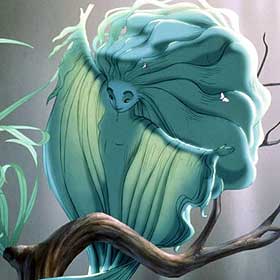Fantasia/Fantasia 2000

5/5
In 1940, Walt Disney devised a project that would revolutionize not only animation, but the role of music in film. He envisioned it as something that would be more than just a movie, but a full on sensory experience. Seventy years back, Disney pictured the possibility of wide screens, 3D renderings and even perfumes that would be sprayed directly into theaters. Moviegoers would dress up in evening wear and show up to the theater to find reserved seating, before the auditorium went dim and the new technology of Fantasound rang out from the 30 speakers rigged around the seats. This project was called Fantasia.
Disney originally intended that a new installment of Fantasia would be released every year. It didn't exactly pan out; Fantasia was too advanced for its own good. With avant-garde touches permeating the sometimes abstract, but always stunning, animation, Fantasia befuddled the audience it was meant to enchant. It was the studio's biggest commercial failure of the time. With time, critics restored the movie to its proper heights in the pantheon, where it is regarded as Disney's lasting masterpiece. It was not until 2000 that Disney saw fit to try again, with the logically named, Fantasia 2000. Fantasia 2000 is a movie that bears its awareness of its predecessor with pride. The original enterprise is no longer the foolish miscalculation it had seemed at the time, but a hallmark of the Disney brand. Though geared towards a slightly more childish set, the reboot pays homage as best it can.
For those who haven't seen either film, it's hard to encapsulate the unique pleasure of the Fantasia experience. There is no other movie in the world like these movies. Essentially a sequence of unconnected animated shorts, each set wordlessly to a piece of beautiful orchestral music, the original shows the orchestra warming up between each piece, as if you are indeed in the theater experiencing at last the fusion of sight and sound the way it was meant to be. From the charming and iconic "Sorcerer's Apprentice" sequence to the ghoulish horror of "Night on Bald Mountain" to the abstract wonder of the "Toccata and Fugue," Fantasia provides a full suite of the capabilities of animation to lend rich and nuanced explication of symphonic music. Music is storytelling: not just narrative, but also feeling. Fantasia 2000, while not quite as powerful, needs no other argument than its New Yorker-influenced rendition of George Gerschwin's "Rhapsody in Blue." It's a love letter to the history and spirit of New York that has rarely been matched.
Finally, Disney has decided to release both movies in special edition that compiles both into a DVD/Blu-Ray pack, replete with special features. The DVD part of the set includes the requisite audio commentary, as well as a fascinating documentary on Walt Disney's never-completed idea for a sequel, Musicana, which explores the failed 1970s idea for a Fantasia-like movie that would focus on exploring other cultures through music. Special features on the Blu-Ray edition outpace the DVD by a mile. Additional audio commentary by key figures like conductor James Levine, executive producer Roy E. Disney, and animation historians are invaluable to any enthusiast. Even more thrillingly, the Blu-Ray contains surrealist Salvador Dali's short "Destino," which, though not intended for Fantasia, is a gorgeous example of the art. A documentary surrounding the making of "Destino" is also included, detailing its curious journey from its 1946 inception to its 2003 release.
It's hard to say anything about Fantasia that hasn't already been said. It's the kind of movie that many children remember watching like a strange implanted dream: drifting colors, fantastical landscapes, magnificent sounds. But re-watching the movie bore proof that adulthood hasn't tarnished the experience. Even with increasingly advanced technological impositions into the animated world, nothing diminishes the pure, gorgeous lines of the 1940 classic.
RELATED ARTICLES
Get the most-revealing celebrity conversations with the uInterview podcast!







Leave a comment